You can’t beat Botswana for its beautiful natural surroundings, friendly people, and wide range of stunning fauna and flora. Spend some time in this amazing country, and you’ll be hooked by the quiet majesty of the place and its sense of peace and tranquility. Most travelers flock to Botswana year-round for its incredible wildlife.
Read on for our list of the 11 most likely animals you’ll see in Botswana.
1. Elephants
Elephants follow a very structured social order, with females spending their whole lives in family groups made up of mothers, aunts, sisters, grandmothers, and daughters. Elephants are the gentle giants of the wilderness and are a (literally!) big hit with travelers.

These magnificent creatures usually exist in big herds and like being close to water sources where they can bathe and refresh themselves under the harsh African sun. Elephants are one of the iconic Big Five.
Interesting Elephant Facts:
Elephants are the planet’s largest land mammal. They can weigh up to 6000kg (6.6 tons) and measure up to 3.3m (10ft) at the shoulder. Elephant trunks are extremely versatile and are used to smell, breathe, detect vibrations, suck up water, grasp grass and branches, and care for their young.
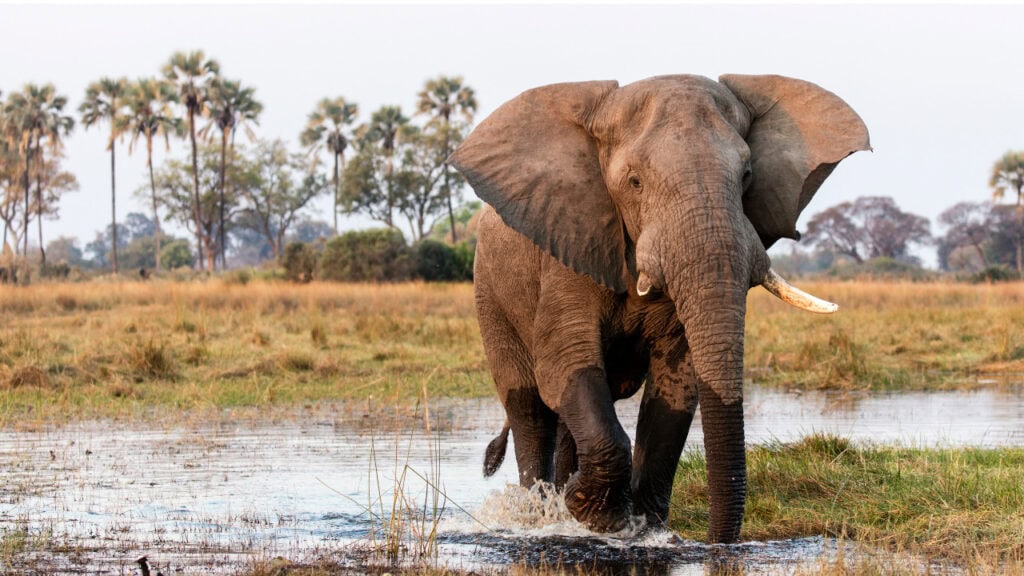
Elephant tusks are used to dig, forage, fight, and as a resting place for heavy trunks.
Where to find elephants in Botswana:
Chobe National Park is famous for being home to the world’s largest herds of wild elephants. You’ll also be able to spot them easily in the Okavango Delta.
2. Giraffes
Giraffes are the earth’s tallest mammals. These incredible, long-necked creatures make for amazing wildlife shots and aren’t bothered much by being approached closely.
Interesting Giraffe Facts:
Giraffe legs are about 1,82m long, and at full gallop, giraffes can reach a speed of 56 kilometers per hour over short distances. A giraffe will spend most of its life standing up and will even give birth and sleep standing up.

Giraffe calves can stand up and walk within an hour of being born. A giraffe’s spots are almost like fingerprints – no two giraffes have the same pattern.
Where to find giraffes in Botswana:
Giraffes are seen throughout central and northern Botswana, especially in the Central Kalahari, Chobe National Park, and the Okavango Delta.
3. Wild Dogs
Wild dogs vote to initiate a hunt by sneezing and are very efficient hunters. These endangered creatures have a brindle-like coloring and look a lot like domesticated dogs but are ruthless predators. Wild dogs are highly strategic and almost never fail at capturing their prey.
Interesting Wild Dog Facts:
Female wild dogs are larger than males and are more skilled at hunting. In pack relations, only the alpha pair are allowed to breed, and the rest of the pack looks after the young.
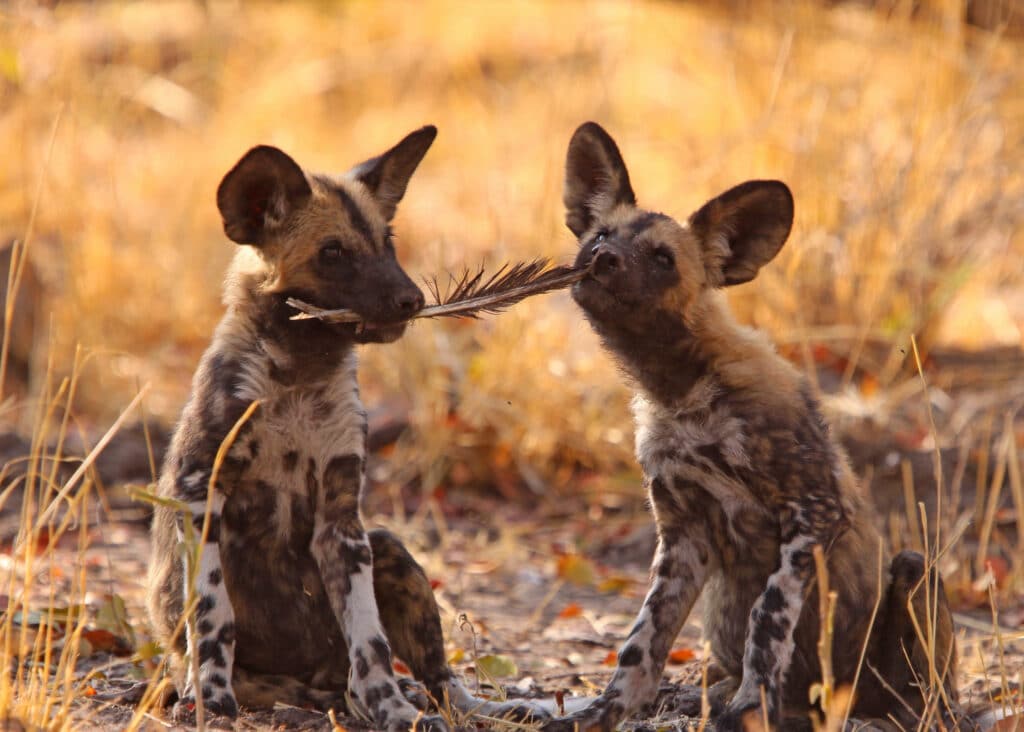
Wild dogs have unique coats, rounded ears, and, unlike other dogs, four toes on each foot. Wild dogs can run at up to 44 miles per hour.
Where to find wild dogs in Botswana:
Wild dogs can often be found in Moremi Game Reserve and in Northern Botswana (Okavango Delta, Linyanti, Savuti, Kwando, and Selinda)
4. Wildebeest
Wildebeest have many natural predators, from lions, hyenas, and cheetahs, to African wild dogs. For this reason, wildebeest gather in groups of around 150 during breeding and calving season. Wildebeest co-exist with zebras, so if you spot one, you won’t have to look far to see the other.

Wildebeest translates to ‘wild beast’, and the name is derived from their appearance and ill-tempered nature. Wildebeest live and travel in large herds as a means of protection, and both males and females sport a massive set of horns.
Interesting Wildebeest Facts:
Wildebeest are most often found in areas of dense bushlands, woodland floodplains, and open grasslands. When they’re about one year old, males tend to leave the herd and join a bachelor herd. After about three or four years, these males become extremely territorial and leave the group.

Female wildebeest give birth to one calf, usually in the center of the herd. Wildebeest calves are able to stand fully after only about six minutes of being born.
Where to find wildebeest in Botswana:
You’ll be able to find wildebeest reliably in the Makgadikgadi Pans National Park as well as the Okavango Delta.
5. Rhinos
Rhinos are an endangered species due to being poached for their horns. Many rhinos have been moved from South Africa to Botswana because of the poaching threat.
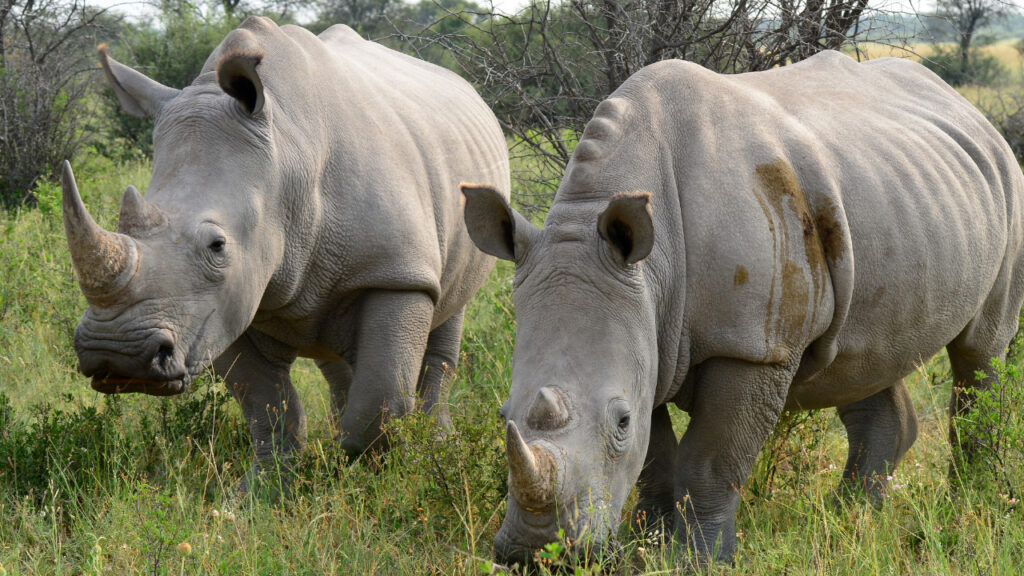
Conservation and anti-poaching efforts in Botswana are doing a good job of keeping these majestic creatures safe from harm.
Interesting Rhino Facts:
Rhino horns are made of the same biological material as human skin and nails. You’ll often find rhinos caked in mud, which acts as a sunblock and protects them from insects. The collective noun for rhinos is a crash of rhinos.
Where to find rhinos in Botswana:
You’ll be able to spot rhinos in the concessions surrounding the Okavango Delta.
6. African Buffalo
African buffalo can weigh anything from 300kg to 860kg and sport a set of horns that can grow up to 1,5m long. African buffalo roam in large herds throughout Botswana. They’re a favorite prey for lions, so keep an eye out for these deadly predators whenever you come across a herd.
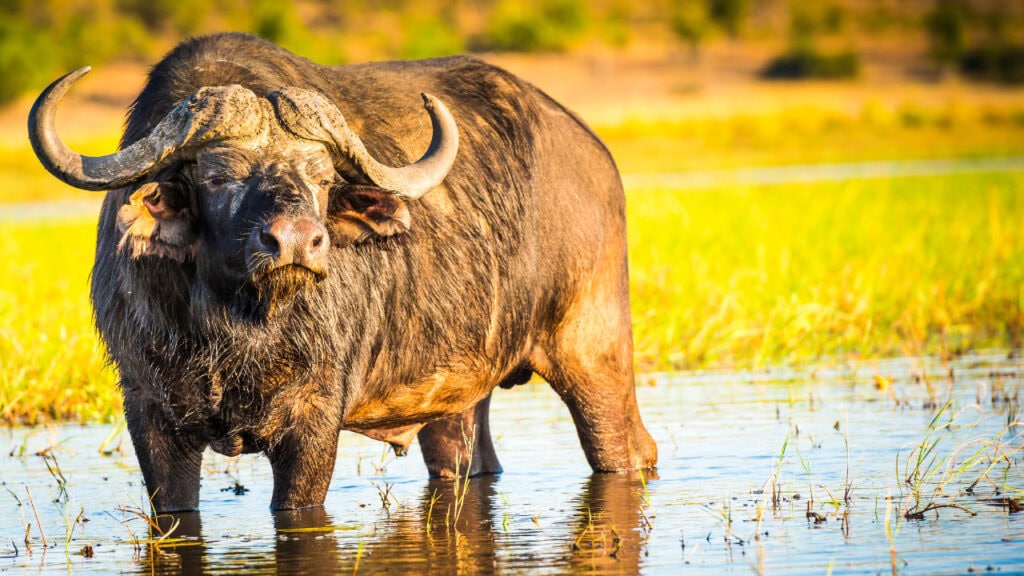
Buffalo are one of the famous Big Five that attracts safari fans from across the world.
Interesting Buffalo Facts:
Buffalo have an excellent memory and are four times stronger than an ox. When there are predators around, buffalo form a circle around the young, old, and weak members of the herd. Buffalo have poor eyesight and hearing, but this is made up for with an exceptional sense of smell.
Where to find buffalo in Botswana:
You’ll easily find African buffalo on safari in Chobe National Park and the Okavango Delta.
7. Zebras
Although they’re related to horses, zebras have wild temperaments and are far more aggressive and dangerous. The zebra is Botswana’s national animal, and you’ll have no problem spotting them wherever you go in Botswana. Due to their dazzling black and white stripes, they can look like a bit of a blur from a distance.

This effective camouflage can make it difficult for predators to hunt them in a herd.
Interesting Zebra Facts:
There are three different species of zebra; Grevy’s zebra, the mountain zebra, and the plains zebra. Like donkeys and horses, zebra are part of the Equidae family. At full gallop, zebras can reach a speed of up to 65 kilometers per hour and run in a zig-zag fashion when being pursued by predators.
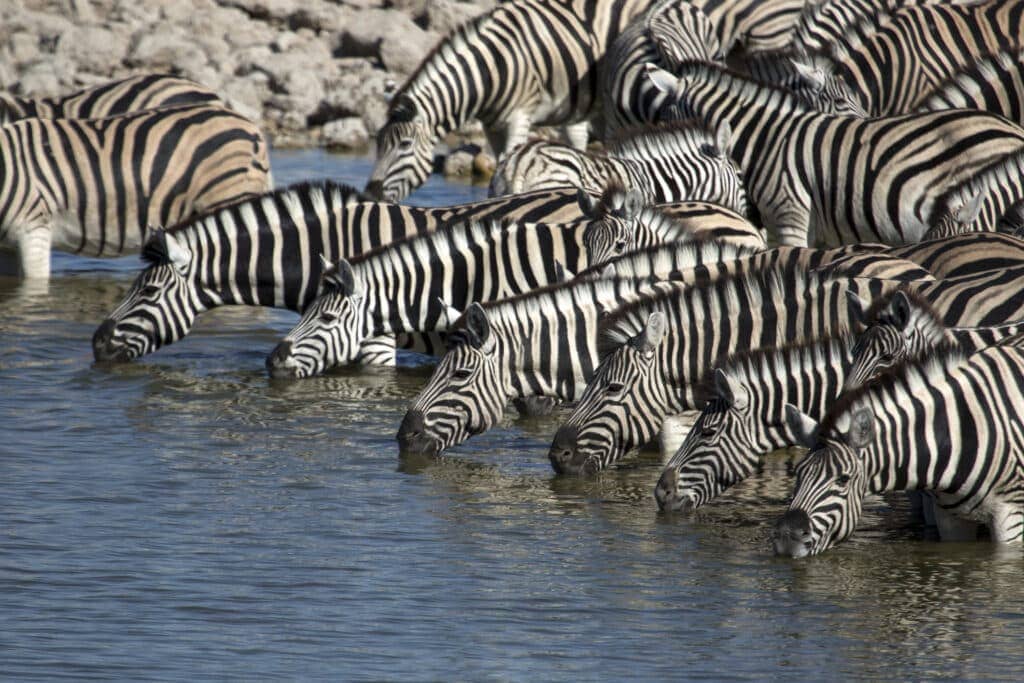
Newborn zebra foals can start running with the herd only a few hours after being born.
Where to find zebras in Botswana:
Zebras migrate to the Makgadikgadi Game Reserve during the rainy season but can also be found in the Chobe National Park, Savute, and Okavango Delta.
8. Hippos
Hippos are highly territorial in the water. They back up their bulk with a powerful bite, the fourth most powerful in the world! Although dangerous creatures, hippos usually live as a group of friends, although some can be solitary.
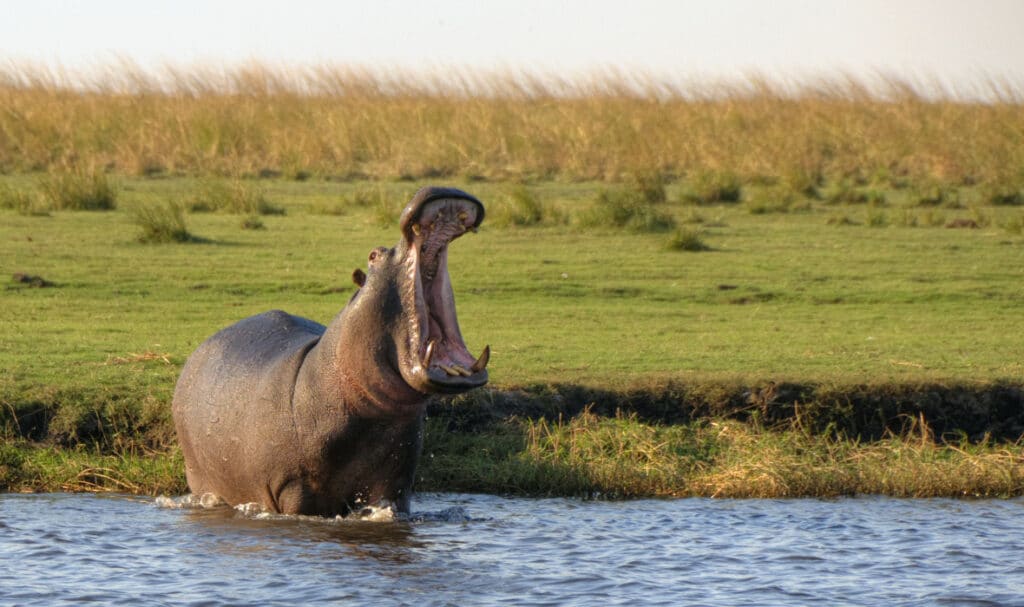
Male hippos can display dominance, but these are usually kicked out of the herd, being perceived as a threat to the other males. Hippos spend a lot of time in the water – sometimes so submerged that you’ll only be able to spot their eyes and nostrils.
Interesting Hippo Facts:
Hippos spend most of their time on the shoreline. They secrete an oily red substance that can look like blood but is actually a skin moisturizer and sunblock. An adult hippo can hold its breath underwater for between three and five minutes.

At birth, hippo calves weigh about 45kgs and can suckle underwater by closing their nostrils. Hippos spend up to four or five hours grazing every day and can consume up to 70kgs of grass in one night.
Where to find hippos in Botswana:
You’ll find hippos in abundance close to water sources in the Okavango Delta and the Chobe River.
9. Lions and Lionesses
The role of a lion is all about establishing and maintaining dominance, as well as fathering lion cubs. In Botswana, lions and lionesses live in abundance. If you’re lucky enough to witness a lioness going in for the kill, it’s a spectacle you won’t soon forget.

These big cats regularly feast on buffalo and impala, but between hunts, they can often be found lazing under a shady tree or roaming their territory. Facing no real competition, lions and lionesses are often referred to as the kings and queens of the African bushveld.
They are one of the Big Five and the second-largest cat in the world.
Interesting Lion and Lioness Facts:
Lions spend most of their time defending their territory and guarding their cubs, while lionesses do most of the hunting. Lions and lionesses can spend 16-20 hours every day sleeping or resting.

It’s thought that the darker the mane of a male lion, the more attractive it is to lionesses because lions with darker manes tend to have higher levels of testosterone. Lions aren’t fussy about terrain as long as there’s a good supply of food.
Where to find lions and lionesses in Botswana:
Lions can be found in most places throughout Botswana, from the outskirts of the Okavango Delta to the dry areas near the Kalahari Desert.
10. Leopards
Leopards are very solitary creatures who spend most of their time patrolling their own territory. When you can spot these elusive creatures, you’ll be rewarded with seeing one of the wild’s most photogenic and charismatic animals.

Leopards are one of Africa’s iconic Big Five and are usually found around rocky hills or in dense riverine bush. They usually emerge in the late afternoon or at night to hunt.
Interesting Leopard Facts:
Leopards are the third biggest cat in the world and can weigh between 60kg and 70kg. Leopards tend to stalk or ambush their prey rather than chase it down like a lioness or a cheetah.
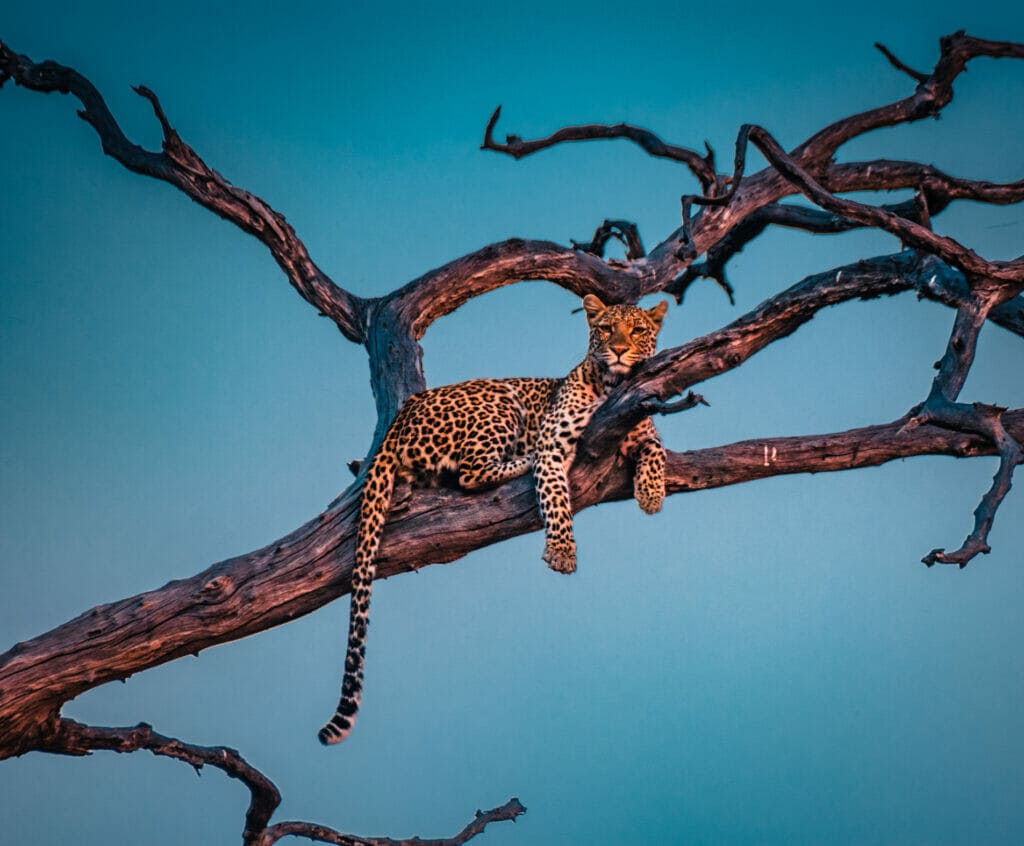
Leopards can carry animals much heavier than themselves and often drag their prey into high places in tall trees in order to protect it from scavengers like hyenas.
Where to find leopards in Botswana:
Leopards can be found lounging in the branches of a shady tree, roaming the sands of the Kalahari, or deep in the Moremi Game Reserve and Okavango Delta. You can also spot them on the banks of the Chobe River, the only permanent water source in Chobe National Park.
11. Meerkats
At just 50cm in length (tail included!), meerkats have got to be one of the cutest animals you’ll find in all of Botswana. Come across a colony of meerkats, and you’ll always see at least one standing on its hind legs, keeping a lookout for predators.
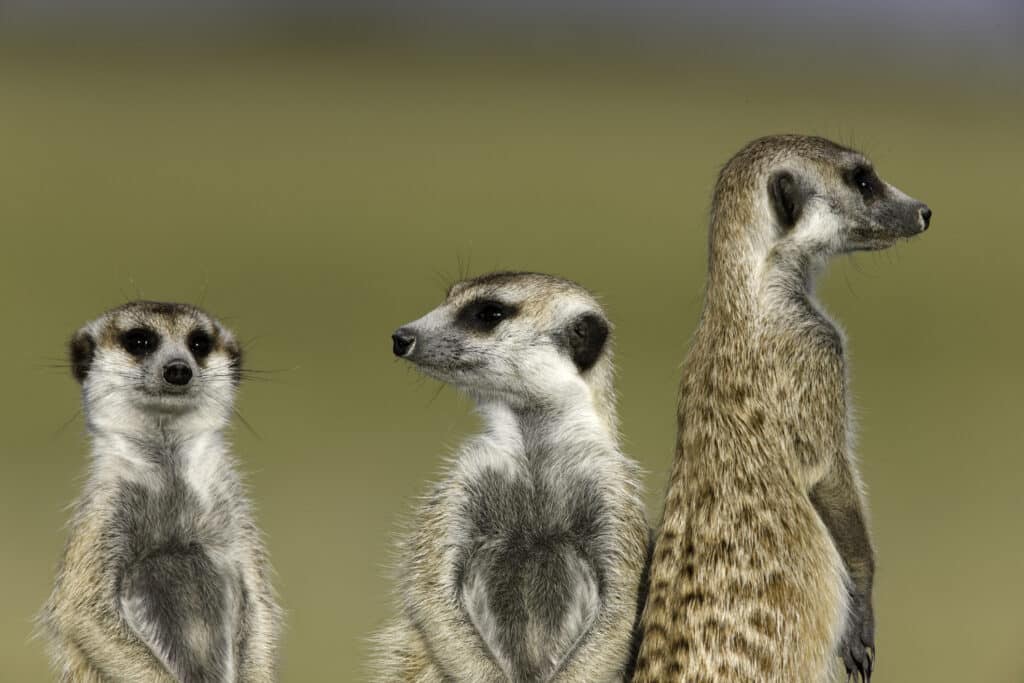
Meerkats are highly social creatures. Don’t be surprised if one clambers up onto your shoulders – they’re always looking for higher ground.
Interesting Meerkat Facts:
Meerkats live in family groups called mobs or gangs. These gangs are led by an alpha pair, and the alpha female is the most dominant in the group. Meerkats are cunning and can eat snakes and poisonous scorpions.
Where to find meerkats in Botswana:
You’ll easily be able to come across meerkats in Makgadikgadi Pans in Botswana.
Author: Gavin Denner
Published:
Last Update:
Part of the Botswana Safari Collection